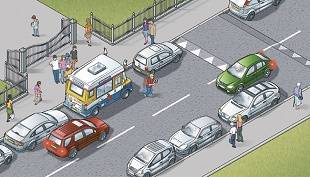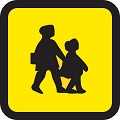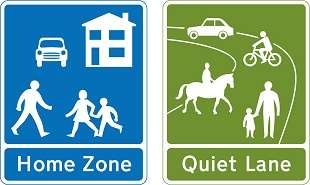Road Users Requiring Extra Care
Rule 204: Watch out for ‘potentially’ dangerous and vulnerable road users such as:
- Ramblers and foot pedestrians.
- Cyclists and motorcyclists.
- Horse riders.
- Other high risk or unusual vehicles.
Drivers should also be particularly aware of children playing near to the road. Look out for older and disabled people using the pavement. Be mindful of inexperienced learner drivers and riders blending in with everyday traffic.
Pedestrians
Rule 205: There is a risk of pedestrians, especially children, stepping unexpectedly into the road. You should drive with the safety of children in mind at a speed suitable for the conditions.
Rule 206: Motorists should always watch out for children in busy areas. Thus, drive carefully and slowly when:
- You are driving in crowded shopping streets, residential areas, and Home Zones or Quiet Lanes.
- Driving past bus and tram stops because pedestrians may emerge suddenly into the road.
- Passing parked vehicles, especially ice cream vans. Children are usually more interested in ice cream than traffic. They may run into the road without warning.
- You need to cross a pavement or cycle track. Give way to pedestrians and cyclists on the pavement (e.g. to reach or leave a driveway).
- You are reversing your vehicle into a side road. Look all around and give way to any pedestrians who may be crossing the road.
- Turning at road junctions. You should give way to pedestrians who are already crossing the road into which you are turning.
- The pavement is closed (e.g. for street repairs) and pedestrians get directed to use the roadway.
- You are approaching pedestrians on narrow rural roads without a proper footway or footpath. Always slow down and be prepared to stop if necessary, giving them plenty of room as you drive past.
Rule 207: The most vulnerable types of pedestrians include:
- Children and older pedestrians. They could suddenly step into the road in front of you because they may find it difficult to judge your speed.
 Older pedestrians who may need more time to cross the road so be patient.
Older pedestrians who may need more time to cross the road so be patient.- People with disabilities. Those with hearing impairments may not be aware of your vehicle approaching. Anyone with walking difficulties requires more time.
- Blind or partially sighted people who often carry a white cane (using a guide dog). They may not be able to see you approaching.
- Deafblind people who may be carrying a white cane with a red band or using a dog with a red and white harness. They may not see or hear your instructions or your signals.
Special Note: At 40 mph (64 km/h) your vehicle will probably kill any pedestrians it hits. At 20 mph (32 km/h) there is only a 1 in 20 chance of the pedestrian getting killed. So kill your speed!
School Zone and Stationary School Bus
Rule 208: Drive slowly near any schools. Be particularly aware of young cyclists and pedestrians around the school entrance. As a rule, there will be a flashing amber signal below the ‘School’ warning sign.
It is there to inform you that there may be children crossing the road ahead. Drive very slowly in these school zones until you are well clear of the area.
 Rule 209: Stationary school buses are typical situations of road users requiring extra care. Be sure to drive carefully and slowly when passing a stationary bus.
Rule 209: Stationary school buses are typical situations of road users requiring extra care. Be sure to drive carefully and slowly when passing a stationary bus.
Children may be getting on or off if there is a yellow square shaped ‘School Bus’ sign showing. The school bus sign should be displayed in the front and rear window of the bus or coach.
Rule 210: You MUST stop when a school crossing patrol shows a ‘Stop for children‘ sign.
Cyclists and Motorcyclists
Rule 211: It is fair to say that all cyclists and motorcyclists are vulnerable road users requiring extra car. As a rule, they are difficult to see and especially when they are moving up from behind you. Cyclists and motorcyclists are relatively unguarded when they coming out of junctions.
The same applies while maneuvering roundabouts, filtering through heavy traffic, and overtaking you.
Always look out for motorcyclists and cyclists at junctions. They will often be the most vulnerable road user at road junctions. They could be approaching faster than you realise.
Watch out for bike riders coming through on the inside of the traffic you are crossing when turning right across a line of slow-moving or stationary traffic. Turning and changing direction or lane requires extra care. Be sure to check your vehicle mirrors and blind spots.
Rule 212: Allow plenty of room for bike riders when you are passing cyclists and motorcyclists. It probably means they intend to pull out, turn right, or change direction if they look over their shoulder. Be a careful driver and give them time and space to make their move.
Rule 213: Unlike cars and trucks, motorcyclists and cyclists need to take more care avoiding uneven road surfaces and obstacles. Examples include drain covers, oily deposits, and wet or icy patches on the road.
Drivers should pay particular attention to any sudden change of direction bike riders make. Give them plenty of room to do so.
Other Vulnerable Road Users
Animals in the Road
Rule 214: Drive slowly when you are passing animals in the road or at the roadside. Give them plenty of room and prepare to stop your vehicle if necessary. Sounding your horn will scare animals. So will revving your engine or accelerating with speed after passing them.
Take extra care and look out for animals being led, driven, or ridden on the road. Reduce your speed at bends and on narrow country roads. It may be prudent to ‘stop’ and switch off your engine if a road gets blocked by a herd of animals until they have left the road. Be vigilant and watchful for animals on unfenced roads.
Riding Horses on the Roads
Rule 215: All motorists should be particularly careful of horse riders and horse-drawn vehicles. This is especially so when overtaking them. Always pass wide of horses and drive around them with reduced speed.
Horse riders are often children. Take extra care and remember riders may ride in double file when escorting a young or inexperienced horse or rider. Take great care and treat all horses as a potential hazard. That means looking out for horse riders and horse drivers’ signals. Heed their request for you to slow down or stop your vehicle.
Older Drivers
Rule 216: Make a special allowance for older drivers. They are likely to have slower reaction times and response rates than other drivers.
Learners and Inexperienced Drivers
Rule 217: Learners and inexperienced drivers may not be so skilful at anticipating and responding to events happening on the roads. Thus, be particularly patient and courteous with learner drivers and young drivers. Drivers who have recently passed their test may be displaying a ‘new driver’ plate or sticker on their vehicle.
Home Zones and Quiet Lanes
 Rule 218: They are not so common in city centers and in heavy traffic. But, Home Zones and Quiet Lanes are places where people could be using the whole of the road for a range of different activities. One of the most likely reasons is for children playing or for a community event.
Rule 218: They are not so common in city centers and in heavy traffic. But, Home Zones and Quiet Lanes are places where people could be using the whole of the road for a range of different activities. One of the most likely reasons is for children playing or for a community event.
You should drive slowly and with extra care. Prepare to stop to allow people extra time to make space for you to pass them in safety.
High Risk Vehicles
Emergency and Incident Support vehicles
Rule 219: The UK Highway Code has rules on emergency vehicles. All motorists should look and listen for ambulances, fire engines, police, or doctors using flashing blue, red, or green lights. This also includes those with sirens or flashing headlights, traffic officers, and incident support vehicles using flashing amber lights.
Do not panic if an emergency vehicle approaches you. Instead, consider the route that the vehicle is likely to need. Take appropriate action to let it pass (while complying with all traffic signs).
Pull to the side of the road and stop if necessary. But, try to avoid stopping before the brow of a hill, a bend, or narrow section of road.
Note: You should not endanger yourself, other road users, or pedestrians. Avoid mounting the kerb. Do not brake harshly on approach to a junction or roundabout. Vehicles behind may not have the same view.
Powered Vehicles and Mobility Scooters
Rule 220: Powered vehicles, invalid carriages and mobility scooters are most often used by disabled people. These small vehicles travel at a maximum speed of 8 mph (12 km/h). They MUST have a flashing amber beacon on a dual carriageway where the speed limit exceeds 50 mph (80 km/h). Even so, you may not have that advance warning from powered vehicles on other roads.
Large Vehicles
Rule 221: Extra-large vehicles, such as buses and articulated Lorries, need extra road space. This is more so when turning or dealing with hazards that you may not be able to see. Be aware that the driver may not be able to see you in the mirrors if you are following a large vehicle. Be prepared to stop and wait if it needs room or time to turn.
Rule 222: Your ability to see and to plan ahead may be impaired because large vehicles can block your view. Pull back to increase your separation distance. Many large vehicles may have speed limiting devices fitted.
Speed limiters will restrict their speed to 56 mph (90 km/h) even on a motorway. So, larger vehicles are subject to lower speed limits than cars and motorcycles. Be patient if you get stuck behind one.
Buses, Coaches, and Trams
Rule 223: Look out for people getting off a bus or tram and crossing the road. Give priority to these vehicles when you can do so safely. Watch out when they signal to pull away from stops.
Electric Vehicles
Rule 224: Electric vehicles such as milk floats, trams and streetcars are not too common. But, they do fall into the category of road users requiring extra care. Trams move quite fast but they are silent – for the most part. They cannot steer to avoid you or your vehicle.
Vehicles with Flashing Amber Beacons
Rule 225: Most vehicles with flashing amber beacons are used to warn motorists that it is a slow-moving or stationary vehicle. Vehicles with flashing amber lights are most often used by traffic officer vehicles, salt spreaders or snow ploughs, recovery vehicles, or abnormal loads. Approach these situations with caution.
Note: On unrestricted dual carriageways, motor vehicles first used on or after 1 January 1947 with a maximum speed of 25 mph (40 km/h) or less (such as tractors) MUST use a flashing amber beacon.

